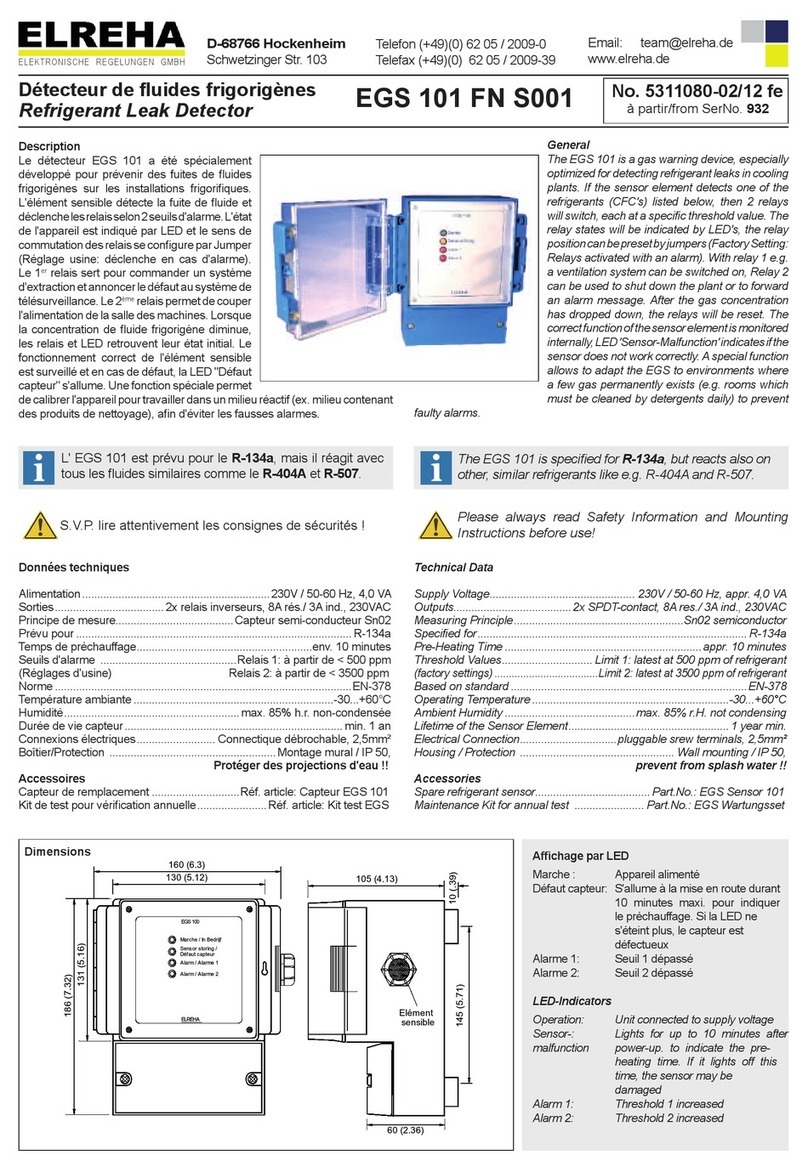
Kurzbeschreibung
Die Gaswarngeräte der Serie EGS sind speziell
zumMeldenvonKältemittellecksinKälteanlagen
optimiert. Wird ein FKW-Kältemittel detektiert,
dann schaltet bei den genannten Schwellwer-
ten jeweils ein Relais. Der Schaltzustand wird
durch LED's angezeigt, die Schaltrichtung ist
(typenabhängig) per Jumper auswählbar. Mit
der ersten Stufe kann z.B. eine Absaugvorich-
tung eingeschaltet werden, mit Stufe 2 kann die
AnlageabgeschaltetodereineStörmeldungwei-
tergeben werden. Nachdem die Konzentration
wieder gesunken ist, werden Relais und LED's
zurückgesetzt.DiekorrekteFunktiondesSenso-
relementswirdinternüberwacht,typenabhängig
wirdeinFehlerangezeigt(LED"Sensorstörung").
EGS können an Umgebungen mit permanenter,
leichter Gasbelastung (z.B. Räume mit scharfen
Putzmitteln) angepasst werden, um Fehlalarme
zu vermeiden. Über eine RS-485-Schnittstelle
sind die EGS (nicht 101) in ein Reglernetzwerk integrierbar, Parameter lassen
sich darüber auslesen und einstellen.
Brief Description
The EGS is a gas warning device, especially
optimized for detecting refrigerant leaks in cooling
plants. If the sensor element detects one of the
refrigerants (CFC's) listed below, then 2 relays will
switch,eachataspecificthresholdvalue.The relay
states will be indicated by LED's, the relay position
canbepreset(dependingontype)byjumpers.With
relay 1 e.g. a ventilation system can be switched
on, Relay 2 can be used to shut down the plant
or to forward an alarm message. After the gas
concentration has dropped down, the relays will
reset. The correct function of the sensor element
is monitored internally, LED 'Sensor-Malfunction'
(not 2101) indicates if the sensor does not work
correctly. A special function allows to adapt the
EGS to environments where a few gas perma-
nently exists (e.g. rooms which must be cleaned
by detergents daily) to prevent faulty alarms. The
EGS (not 101) can be networked via an RS-485-
interface, parameters can be set and read out by PC-software.
ELEKTRONISCHE REGELUNGEN GMBH
Telefon (+49)(0) 62 05 / 2009-0
Telefax (+49)(0) 62 05 / 2009-39
D-68766 Hockenheim
Schwetzinger Str. 103
Email: sales@elreha.de
www.elreha.de
Kältemittel-Leckwarner
Refrigerant Leak Detector
No. 5311080-00/19ge
EGS 101 ab/from SerNo. 1645,
EGS 2101 ab/from SerNo. xxxx
EGS 4101 ab/from SerNo. 13
EGS 101, 2101, 4101, 24101
DieSensorender EGSLeckwarnersind fürdie Kältemittel/
FluorkohlenwasserstoffeR134a spezifiziert,besitzenaber
Querempfindlichkeiten zu anderen FKW und Stoffen.
Siereagierendaher aufKältemittelmitähnlichenBestand-
teilen, wie z.B. R22, R404a, R407c, R407f, R417a, R449a
und R507. Empfindlichkeiten und Eckwerte der Reaktion
können aber abweichen. Please always read Safety Information and Mounting
Instructions before use!
Please consider the necessary functional test intervals!
Bitte Sicherheitshinweise vor dem Anschluss lesen!
Bitte Funktionstest-Intervalle beachten!
The sensors of the EGS are specified for the refrigerants/
CFC's R134a, but are also sensitive to other CFC's and
substances. They react on refrigerants with related ingredi-
ents like e.g. R-22, R-404a, R407c, R407f, R417a, R449a
and R-507, but basic values and sensitivity may differ.
Technische Daten
Betriebsspannung / Leistungsaufnahme ..........siehe oben / max. 7,0 VA
Ausgänge ........................2x Wechsler pot.frei, 8A res./ 3A ind., 230VAC
Ausgänge EGS 2101.......2x Wechsler pot.frei, 6A res./ 3A ind., 230VAC
Messprinzip / abgestimmt auf............................SnO2 Halbleiter / R134a
Aufwärmzeit......................................................................ca. 10 Minuten
Alarmschwellen .......Stufe 1: spätestens bei 500 ppm Kältemittel R134a
(Werkseinstellung) Stufe 2: spätestens bei 3500 ppm Kältemittel R134a
Normbezug............................................................................... EN-378-3
Betriebstemperatur................................................................ -30...+60°C
Umgebungsfeuchte ...........................max. 85% r.F. nicht kondensierend
Lebensdauer des Sensorelements..............................abhängig von den
Umgebungsbedingungen (siehe Anschlusshinweise)
Bauform EGS 101, 4101, 24101
Elektrischer Anschluss.............. Steckbare Schraubklemmen, 2,5mm²
Gehäuse/Schutzart .......................................... Wandmontage / IP 50,
vor Spritzwasser schützen !!
Bauform EGS 2101
Elektrischer Anschluss
Relaisausgänge................................................. Schraubklemme 2,5 mm²
Schnittstelle ................................................. Schraubklemme 1,5 mm²
Gehäuse/Schutzart ......................... Kunststoff, Wandmontage / IP 54
vor Spritzwasser schützen !!
Zubehör
Ersatz-Kältemittelsensor..............................Best.Bez.: EGS Sensor 101
Technical Data
Supply Voltage / Power Consumption ...............see above / max. 7,0 VA
Outputs................................ 2x SPDT-contact, 8A res./ 3A ind., 230VAC
Outputs EGS 2101 .............. 2x SPDT-contact, 6A res./ 3A ind., 230VAC
Measuring Principle / specified for............ SnO2 semiconductor / R134a
Pre-Heating Time .......................................................... appr. 10 minutes
Threshold Values........... Limit 1: latest at 500 ppm of refrigerant R 134a
(factory settings)................Limit 2: latest at 3500 ppm of refrigerant
R 134a
Supports you for standard ........................................................ EN-378-3
Operating Temperature ......................................................... -30...+60°C
Ambient Humidity .....................................max. 85% r.H. not condensing
Lifetime of the Sensor Element .......................................depends on the
environmental conditions
Types EGS 101, 4101, 24101
Electrical Connection.................... pluggable screw terminals, 2,5mm²
Housing / Protection .........................................Wall mounting / IP 50,
prevent from splash water !!
Type EGS 2101
Electrical Connection
Relay Outputs ............................................... screw terminals, 2,5mm²
Data Interface ............................................... screw terminals, 1,5mm²
Housing / Protection ............................. plastic, wall mounting / IP 54,
prevent from splash water !!
Accessories
Spare refrigerant sensor................................Part.No.: EGS Sensor 101
Type Overview
Supply Interface
EGS 101................ 230V / 50-60Hz.............--
EGS 2101 .............. 12-24V AC/DC ..............RS-485
EGS 4101.............. 230V / 50-60Hz.............RS-485
EGS 24101............ 115V / 60Hz ..................RS-485
Typenübersicht
Betriebsspannung Schnittstelle
EGS 101................ 230V / 50-60Hz.............--
EGS 2101 .............. 12-24V AC/DC ..............RS-485
EGS 4101.............. 230V / 50-60Hz.............RS-485
EGS 24101............ 115V / 60Hz ..................RS-485

























